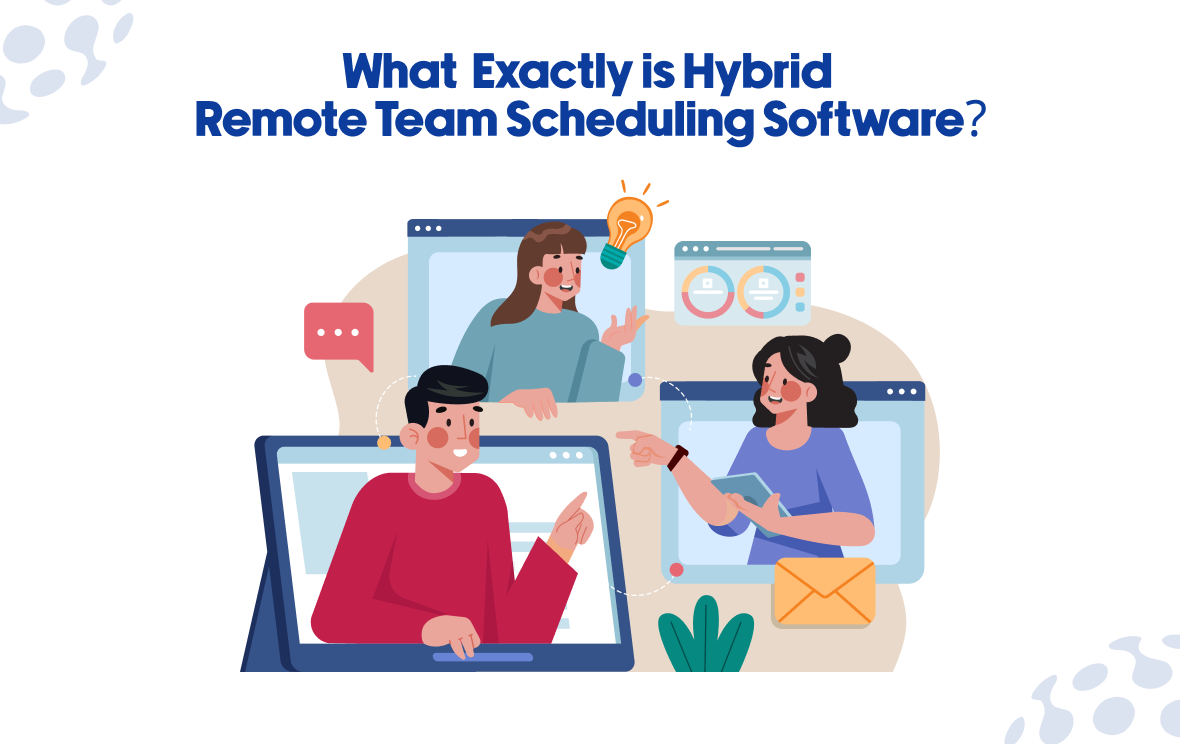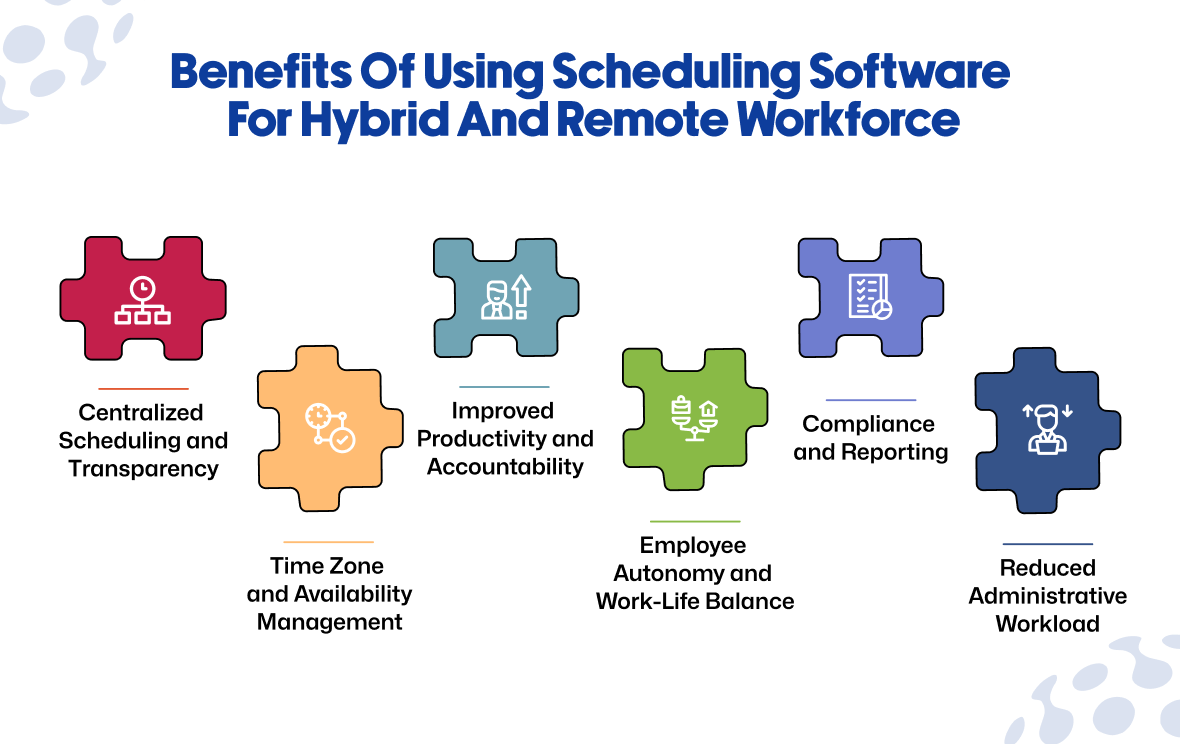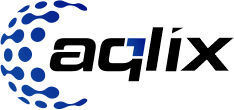Business leaders are hailing the shift to hybrid and remote work, but it hasn’t come without growing pains. From juggling employees on different time zones to focusing on accountability without micromanaging, businesses are finding smarter ways to run their operations. That’s where remote team scheduling software comes into play. With scheduling being automated through digitization, organizations can be transparent in their operations improve productivity and keep their employees motivated.
What Exactly is Hybrid Remote Team Scheduling Software?

Essentially, employee scheduling software assists companies in arranging and tracking work schedules in an organized manner. Current scheduling applications are web-based, mobile-friendly and provide easy-to-view updates (unlike old-fashioned paper schedules).
Some standout features include:
Cloud access: Managers and employees can access their accounts at any time, from anywhere.
Mobile capabilities: Employees can get shift updates and trade schedules on the fly.
Real-time adjustments: Last-minute changes are updated real time for all participants.
This digital approach for scheduling can help clear up confusion and instill order in hybrid or decentralized teams.
Benefits Of Using Scheduling Software For Hybrid And Remote Workforce

1. Centralized Scheduling and Transparency
When everyone can consult the identical live schedule, miscommunication vanishes. A central dashboard keeps employees on time and task, with minimum overlap or missed tasks.
2. Time Zone and Availability Management
For teams around the world, scheduling software converts working hours into local time zones automatically. This keeps collaboration strong and commands moving smoothly, regardless of where your employees are working from.
3. Improved Productivity and Accountability
It’s easier for managers to give shifts, assign tasks and assign responsibilities. Workers receive reminders, and managers can monitor progress in real time. The combination of independence with exposure is what breeds responsibility.
4. Employee Autonomy and Work-Life Balance
A reputable scheduling platform should let employees request leave, swap shifts or modify working hours digitally — minus a never-ending exchange of emails. Such flexibility increases satisfaction, lowers burnout and aids in retaining top talent.
5. Reduced Administrative Workload
Attendance logs, leave approvals and shift planning are automated, HR says. This gives HR teams time to actually move into higher-level strategic growth activities instead of paper-pushing.
6. Compliance and Reporting
Whether on labor laws or overtime hours, compliance is not optional. Scheduling software enables companies to remain compliant while creating comprehensive reports for use in audits or workforce analysis.
Some Real-World Uses for Scheduling Software
IT Companies Managing Global Teams
For tech companies with developers in India, designers in the US and testers in Europe, this is how scheduling software keeps collaboration up-to-date. Daily standups and all-hands meetings can be scheduled in real-time availability.
Hybrid Work Models for Commercial Manufacturing Companies
Factories require workers to be on site, while management and administration can generally work remotely. Smart scheduling fills this gap, so that physical and digital teams are seamlessly aligned.
Service Based Businesses (Call Centers, Consulting companies & Ad agencies)
International service businesses are built on being available. And with scheduling tools, shifts can be coordinated to cover around-the-clock overseas customer needs — be they 24/7 support or time-sensitive consulting.
There are many challenges in scheduling software implementation.
Integration with Existing Systems
Scheduling software needs to be integrated with CRM, HRM, and ERP solutions. We are experts at digital workforce management integrations, and take pride that our software is easily adopted with minimal interference in your workflow.
Employee Adoption
A perfect tool is only useful if the user adopts it. Effective on-boarding, training and user friendly interface designs enable teams to adopt change more quickly.
Budget and ROI Concerns
The upfront investment may feel overwhelming, but the long-term payoffs —greater productivity, less manual work and increased compliance—are clearly calculable.
What Aqlix IT Solutions can do
We don’t just install an out-of-the-box tool at Aqlix — we create a custom workforce productivity plan that works for your business. Our expertise includes:
- Custom scheduling software for remote and hybrid teams.
- Mobile-first apps that your field team can use
- Scheduling driven by AI for precise demand prediction.
- Seamless Integration with Your Existing ERP, HR or Payroll System.
Our intelligent approach to workforce planning gives businesses the efficiency and flexibility they need – keeping people engaged and operations compliant.
Conclusion
You no longer need to be a headache to manage hybrid and remote workforces. Through the use of good employee scheduling software, companies can reach transparency, productivity and happier employees. The future of work is digital — and the early adopters will reap the benefits of a competitive advantage.
At Aqlix IT Solutions we are making sure businesses have the tools to thrive in this new era of work. If you are ready to simplify your workforce management and realize productivity gains, then our experts can help.
FAQ
1. Can scheduling software also benefit small businesses?
Yes. Whether it’s ten employees or 1,000, scheduling tools grow with you.
2. How does scheduling software help in remote collaboration?
Teams remain aligned even working across continents with real-time updates, automatic time zone adjustment and clear task assignments.
3. Is proprietary scheduling software superior to off-the-shelf tools?
Generic tools are easy to use but may not meet all needs. Bespoke software provides you with flexibility, control and the ability to fit into what you already have going on.
4. How much time does it take to install scheduling software?
The time it takes to implement is based on complexity, but with the right partner you can be set-up within weeks.
5. In which industries does scheduling software work best?
The list is long here — IT, manufacturing, healthcare, retail and call centers are just a few examples of business in which the gains from distributed teams can be enormous.
6. Will the scheduling system auto-ensure compliance?
Yes, an advanced solution collects work hours, overtime and labor law information and automatically generates reports you can use for audits.



